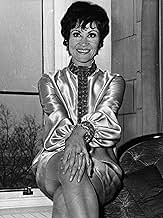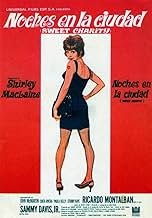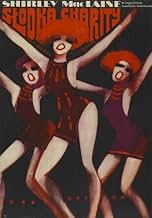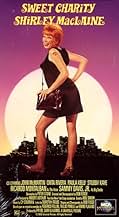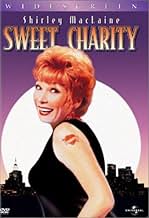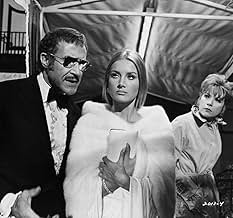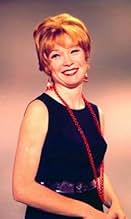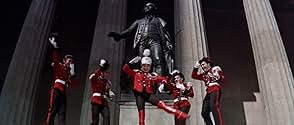Sweet Charity
- 1969
- Tous publics
- 2h 29m
IMDb RATING
6.9/10
7.3K
YOUR RATING
A luckless taxi dancer in New York City seeks a better life and finds love along the way.A luckless taxi dancer in New York City seeks a better life and finds love along the way.A luckless taxi dancer in New York City seeks a better life and finds love along the way.
- Nominated for 3 Oscars
- 6 nominations total
Dante DiPaolo
- Charlie
- (as Dante D'Paulo)
Leon Alton
- Dancer
- (uncredited)
Featured reviews
This is loaded to the brim with that dancing and just general idiosyncratic "cool" feeling that made Fosse who he was as a creator. "Big Spender" and "If My Friends Could See Me Now" are all-timer Musical numbers in film history. And yeah, a couple of the numbers have certainly dated (hearing Sammy Davis tell a bunch of Broadway Hippies to "Sock it to me" in the "Rhythm of Life" number is worth a major eye-roll), plus Fosse's attempts to do uh La Jetee type still image montages at a couple of points. However, Shirley MacLaine is often so moving in a role that others might have played a little less intensely felt (what sold me was the job interview scene, which is just about perfect, but her comic timing is impecable). She's adorable but also very serious as a person, which is hard to pull off.
It's big and flashy and a little bit silly (I like to call Ricardo Montalban Casanova Khan in this), and the director jumps off from Fellini and Neil Simon (in a Peter Stone script) for as much audacious advantage as he can. Not all of it works, but it's far from a "disaster" like Pauline Kael called it. 7.5/10
My love and admiration for Federico Fellini/Guiletta Masina's film Nights of Cabiria had stopped me for long time from seeing Sweet Charity, the adaptation of the musical based on the same story which was made into a highly successful Broadway show directed and choreographed by a multi talented Bob Fosse. I am a fan of Bob Fosse. I love all his films, musicals and not, but I was hesitant to see Sweet Charity the movie and I never had a chance to see the Broadway musical. Well, I finally did and I can say that nothing is wrong with transporting the same story to the different time, place, language, medium, and to use the different artistic tools. The story is the same; the films are as different as Rome and NYC or as Federico Fellini and Bob Fosse. Fosse's film should be judged on its own terms, and it has a lot of breathtaking scenes to enjoy, bright colors, outrageously stunning costumes (the work of incredible Edith Head), adorable and unbelievably cute Shirley MacLaine, Sweet Charity Hope Valentine, and the best of all - the dancing sequences to die for. Among them, splendid The Big Spender is perfection and the real treasure. Fosse's staging of the musical numbers is outstanding. The most memorable moment in the movie for me was stolen from Shirley MacLaine by Chita Rivera in Big Spender. Just watch Rivera's seemingly boneless arms, the right one around her head and the left one behind her back, the left hand on her right hip as she sings, "do you want to have fun, fun, fun?" For this moment alone, I like the film even if I see very well that it has some minuses, too. The first act between two intermissions was really good, and it includes the best dancing and singing numbers: "Hey, Big Spender", "The Pompeii Club", "Rich Man's Frug", and "If They Could See Me Now". After the second intermission the movie went over the hill. I believe that it could do without both intermissions. We are not watching the show at the theater, and the intermissions only took time. The "hippiest" "Rhythm of Life" scene was overlong, did not make much sense, and made me want to fast-forward it. I take it that Fosse wanted to experience with the camera movements and different techniques in his very first feature film which was a screen transfer of his Broadway Musical. This is the only explanation of his multiple slow-motions, stills, color/black/white and back changes that did not add anything to the film, just paused it with no apparent reasons. His next screen adaptation was timeless Cabaret, and he had improved his directing style dramatically. As the result, Cabaret has stayed his greatest achievement along with All That Jazz.
Coming back to the original tragic comedy "Nights of Cabiria", of all the characters Fellini had given life on screen, by his own words, Cabiria was the only one he worried about many years after the film was made. Of all the characters, I've seen in films, Cabiria is the one I often think about - whatever happened to her? Did she survive? Was she able to find love? As much as I like Shirley MacLaine/Charity, I did not worry about her future. She lived happily ever after - in both movie endings, theatrical and alternative.
Coming back to the original tragic comedy "Nights of Cabiria", of all the characters Fellini had given life on screen, by his own words, Cabiria was the only one he worried about many years after the film was made. Of all the characters, I've seen in films, Cabiria is the one I often think about - whatever happened to her? Did she survive? Was she able to find love? As much as I like Shirley MacLaine/Charity, I did not worry about her future. She lived happily ever after - in both movie endings, theatrical and alternative.
Shirley MacLaine is excellent in this underrated, brassy musical based on the Italian classic film, NIGHTS OF CABIRIA.
MacLaine plays Charity Hope Valentine, a sweet but rather clueless woman who works in a dance hall but yearns for love. She's constantly linking up with men who use her, take her money, dump her. The film opens with Charity in Central Park with her "boyfriend." Sitting on a bridge, she chirps about making a wish and throwing something off the bridge. The creep shoves her into the water.
She has two wiser-but-cynical pals, played by Chita Rivera and Paula Kelly. They seem resigned to their fates as dance hall girls but there's still an ember of hope for a better life.
Charity meets an Italian film star (Ricardo Montalban) and spend the night with him ... in his closet. She then meets a repressed man (John McMartin) in a stalled elevator and seems to have found happiness at last..... But is happiness in the cards for Charity? MacLaine seems to channel Gwen Verdon (who starred in the show on Broadway and who worked with MacLaine on the dance numbers) and excels in the many productions numbers, especially "If They Could See Me Now" and "Somebody Loves Me at Last." MacLaine also has a spirited rooftop dance number with Rivera and Kelly as they opine "There's Gotta Be Something Better Than This." The show-stopper is probably the "Big Spender" number which features MacLaine, Rivera, and Kelly with a line of dance hall girls who try to lure men to be their partners. It's a sensational number that shows Bob Fosse's choreographic skills and also demonstrates the cynical life of a dance hall girl.
Other great numbers include MacLaine and Montalban's visit to the Pompeii Club where the dancers go through a series of landmark Fosse dances. The lead dancer here is the sensational Suzanne Charny. Among the dancers are also Ben Vereen, Lee Roy Reams, and Chelsea Brown.
Sammy Davis turns up the heat with the "River of Life" number which shows Charity and Oscar (McMartin)seeking meaning and discovering the 60s counter culture. Then there's Stubby Kaye as the dance hall manager who throws Charity a wedding party and sings "I Love to Cry at Weddings." This is a hugely underrated musical filled with great music and production numbers. Big, bright, brassy, and brazen, what's not to love? MacLaine won a Golden Globe nomination.
MacLaine plays Charity Hope Valentine, a sweet but rather clueless woman who works in a dance hall but yearns for love. She's constantly linking up with men who use her, take her money, dump her. The film opens with Charity in Central Park with her "boyfriend." Sitting on a bridge, she chirps about making a wish and throwing something off the bridge. The creep shoves her into the water.
She has two wiser-but-cynical pals, played by Chita Rivera and Paula Kelly. They seem resigned to their fates as dance hall girls but there's still an ember of hope for a better life.
Charity meets an Italian film star (Ricardo Montalban) and spend the night with him ... in his closet. She then meets a repressed man (John McMartin) in a stalled elevator and seems to have found happiness at last..... But is happiness in the cards for Charity? MacLaine seems to channel Gwen Verdon (who starred in the show on Broadway and who worked with MacLaine on the dance numbers) and excels in the many productions numbers, especially "If They Could See Me Now" and "Somebody Loves Me at Last." MacLaine also has a spirited rooftop dance number with Rivera and Kelly as they opine "There's Gotta Be Something Better Than This." The show-stopper is probably the "Big Spender" number which features MacLaine, Rivera, and Kelly with a line of dance hall girls who try to lure men to be their partners. It's a sensational number that shows Bob Fosse's choreographic skills and also demonstrates the cynical life of a dance hall girl.
Other great numbers include MacLaine and Montalban's visit to the Pompeii Club where the dancers go through a series of landmark Fosse dances. The lead dancer here is the sensational Suzanne Charny. Among the dancers are also Ben Vereen, Lee Roy Reams, and Chelsea Brown.
Sammy Davis turns up the heat with the "River of Life" number which shows Charity and Oscar (McMartin)seeking meaning and discovering the 60s counter culture. Then there's Stubby Kaye as the dance hall manager who throws Charity a wedding party and sings "I Love to Cry at Weddings." This is a hugely underrated musical filled with great music and production numbers. Big, bright, brassy, and brazen, what's not to love? MacLaine won a Golden Globe nomination.
10zetes
There's just something about this movie that I love. I had seen bits and pieces of it some half a dozen times in the past couple of years. Tonight I finally sat and watched all of it. In theory it sounds like blasphemy: a musical remake of Fellini's Nights of Cabiria. But somehow first time director Bob Fosse pulls it off, and enormously well. Fosse is daring and innovative in his direction. Not just in the musical numbers, where you would expect it, but in every scene. He plays, and he's obviously having a ball. After the direction, a high percentage of the film's success is due to Shirley MacLaine, who was never better as Charity Hope Valentine. As much as I love and care for Giullieta Masina's Cabiria, I love and care for MacLaine's Charity. She's such an enormously lovable character, and MacLaine is simply brilliant. Her comic timing is impeccable. Sweet Charity also proves an interesting time capsule of late 60s New York City. In the scene cognate to the Picadilly Club in Nights of Cabiria, we visit a trendy night club where the girls where blue feathers as hats. Clips of Cleopatra (the one with Claudette Colbert) and an unidentifiable W.C. Fields movie play on a big screen in the background. We visit a religious ceremony for hippies who sing The Rhythm of Life. Sammy Davis Jr. is the priest! In Cabiria, a parade of young people cheer her at the end of the film. In Sweet Charity, a group of hippies, amongst them a young Bud Cort, hand out flowers in the morning, just saying good morning to everyone they meet. This movie was a huge bomb when first released. Fosse is actually really lucky they gave him another chance at direction, and then he made a film instantly recognizable as a masterpiece, Cabaret. Sweet Charity did not deserve to fail so miserably. Just the fickle fingers of fate, I guess.
In Sweet Charity, Shirley MacLaine plays Charity, the original hooker with a heart of gold. Well, that's not entirely true; Sweet Charity is a remake of the Italian film The Nights of Cabiria, which won the Oscar for Best Foreign Film of 1957. In any case, the hooker with a heart of gold archetype is embodied by the protagonist in this story.
While the Italian film is depressing beyond belief—Don't get me wrong, I absolutely love the movie and have seen it many times—the musical is slightly different. There are many dramatic, depressing musicals, and this isn't one of them. It's fun and colorful with uplifting songs, a lighter title, and a generally sunny disposition. I won't spoil anything, but if you're looking for a downer, try Oliver instead.
Shirley MacLaine is darling! I know, it seems like I'm always talking about how cute she is, but she is particularly adorable and charming as Charity. Shirley got her start as a dancer, and in this movie, she's able to really show off her skills (and her legs). It's a Bob Fosse musical, so if you've never seen his choreography before, prepare yourself for a very different type of dancing. Dancers will stand perfectly still for several beats, breaking the stillness by a single shoulder shrug or finger flick. It's a very controlled, intense, stylized kind of dancing, one that uses a Hollywood camera to its advantage. The dance numbers are beautifully directed and framed in each shot. Usually, you'll either love Bob Fosse or hate him, so it might be a determining factor in your enjoyment of the film.
It's difficult to pull off the heart of gold hooker role convincingly. In my opinion, Giulietta Masina conveys the "seedy hooker" aspect of the character a little better in the original version, but it's also a darker, sadder film, so that makes sense. In Sweet Charity, Shirley MacLaine chews gum and sports a heart tattoo on her shoulder, but that's about it. Still, she nails the hopeful, utter faith in human nature aspect, which delights audiences and draws them into her story.
When I first watched the movie, I wasn't really too impressed with the songs. Now that I'm older and have written three musicals myself, I actually like Cy Coleman's and Dorothy Fields' creations better. For me, part of what makes an effective musical song is if the melody conveys the words of the song, even if the words are hidden. In "Big Spender", the famous song all the streetwalkers sing to a potential customer, the melody captures the boredom they feel, as well as the frustration simmering underneath. You can really feel it's a song that's been sung a hundred times a night. In "If They Could See Me Now", another famous song that Shirley MacLaine sings with a top hat and cane, it actually sounds like it's being sung on her tiptoes, while she's excited and afraid if she shouts it'll echo off the walls. And finally, one of my favorites, "There's Gotta be Something Better Than This": you can truly feel the frustration boiling over as the girls finally declare they've had enough of their terrible lives. To see what I mean, watch the YouTube clip of the song, and if you like it, rent the movie!
While the Italian film is depressing beyond belief—Don't get me wrong, I absolutely love the movie and have seen it many times—the musical is slightly different. There are many dramatic, depressing musicals, and this isn't one of them. It's fun and colorful with uplifting songs, a lighter title, and a generally sunny disposition. I won't spoil anything, but if you're looking for a downer, try Oliver instead.
Shirley MacLaine is darling! I know, it seems like I'm always talking about how cute she is, but she is particularly adorable and charming as Charity. Shirley got her start as a dancer, and in this movie, she's able to really show off her skills (and her legs). It's a Bob Fosse musical, so if you've never seen his choreography before, prepare yourself for a very different type of dancing. Dancers will stand perfectly still for several beats, breaking the stillness by a single shoulder shrug or finger flick. It's a very controlled, intense, stylized kind of dancing, one that uses a Hollywood camera to its advantage. The dance numbers are beautifully directed and framed in each shot. Usually, you'll either love Bob Fosse or hate him, so it might be a determining factor in your enjoyment of the film.
It's difficult to pull off the heart of gold hooker role convincingly. In my opinion, Giulietta Masina conveys the "seedy hooker" aspect of the character a little better in the original version, but it's also a darker, sadder film, so that makes sense. In Sweet Charity, Shirley MacLaine chews gum and sports a heart tattoo on her shoulder, but that's about it. Still, she nails the hopeful, utter faith in human nature aspect, which delights audiences and draws them into her story.
When I first watched the movie, I wasn't really too impressed with the songs. Now that I'm older and have written three musicals myself, I actually like Cy Coleman's and Dorothy Fields' creations better. For me, part of what makes an effective musical song is if the melody conveys the words of the song, even if the words are hidden. In "Big Spender", the famous song all the streetwalkers sing to a potential customer, the melody captures the boredom they feel, as well as the frustration simmering underneath. You can really feel it's a song that's been sung a hundred times a night. In "If They Could See Me Now", another famous song that Shirley MacLaine sings with a top hat and cane, it actually sounds like it's being sung on her tiptoes, while she's excited and afraid if she shouts it'll echo off the walls. And finally, one of my favorites, "There's Gotta be Something Better Than This": you can truly feel the frustration boiling over as the girls finally declare they've had enough of their terrible lives. To see what I mean, watch the YouTube clip of the song, and if you like it, rent the movie!
Did you know
- TriviaAlthough uncredited, Gwen Verdon was assistant choreographer in the film version of Sweet Charity (1969).
- GoofsIn the "Aloof" movement of "The Rich Man's Frug," two of the male principal dancers walk down the stairs to light a woman's cigarette, while the others dance behind them. The background choreography in this shot leads directly to the triangle formation of the next shot, and the two men are now in the middle of the group, although there was no time for them to reach that position.
- Quotes
Charity Hope Valentine: Wow! This place sure is crawlin' with celebrities. I'm the only person here I never heard of.
- Alternate versionsLaserdisc version contains an alternative ending. After Oscar leaves Charity, he starts to go crazy in his apartment. He then realizes that despite Charity's faults, he really can't live without her. He finds Charity on the bridge in Central Park and, thinking she's going to jump, falls into the river. Charity jumps in after Oscar and forgives him. The two then walk off together, soaking wet, through the park. Bob Fosse thought this ending was too corny, and decided to use the depressing, yet more inspirational, ending for the film's major release.
- ConnectionsFeatured in Sweet Charity: From the Stage to the Screen (1969)
- SoundtracksMy Personal Property
(uncredited)
Music by Cy Coleman
Lyrics by Dorothy Fields
Performed by Shirley MacLaine
- How long is Sweet Charity?Powered by Alexa
Details
- Release date
- Country of origin
- Language
- Also known as
- Sweet Charity: The Adventures of a Girl Who Wanted to Be Loved
- Filming locations
- Production company
- See more company credits at IMDbPro
Box office
- Budget
- $20,000,000 (estimated)
- Runtime2 hours 29 minutes
- Aspect ratio
- 2.35 : 1
Contribute to this page
Suggest an edit or add missing content


